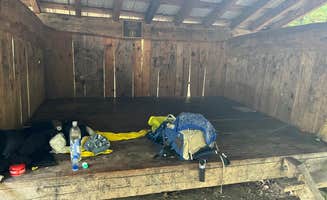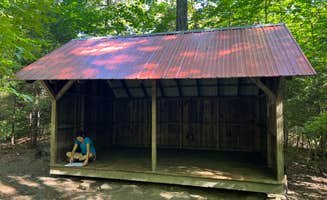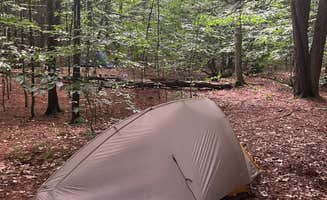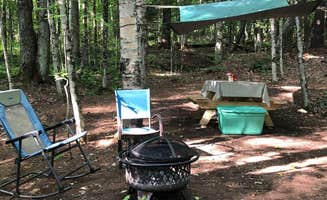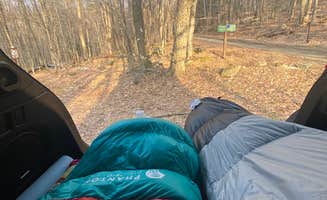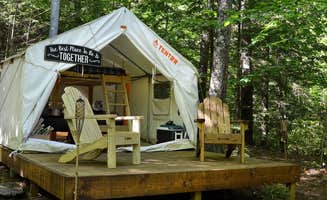Tent camping near Cornish, New Hampshire centers primarily around the Appalachian Trail corridor, with backcountry sites situated at elevations between 1,200-2,800 feet. The area experiences typical New England seasonal variations with summer high temperatures averaging 75-85°F and frequent afternoon thunderstorms. Winter camping requires specialized equipment as temperatures regularly drop below freezing from November through March.
What to do
Hike to swimming holes: At Stony Brook Backcountry Shelter, campers can access a swimming spot just north of the shelter. "There was plenty of water at Stony Brook / Mink Brook a bit further northbound. I only explored a bit offtrail down the brook but found a decent swimming hole (could just barely submerge myself) to clean off a bit," notes a hiker who stayed there.
Summit Mount Cardigan: The climb to Mount Cardigan provides panoramic views from the fire tower. Cardigan Campsites serves as a convenient base for this adventure. "Great spot to spend the night before a climb of Mt. Cardigan! The climb is challenging but shouldn't take too long. Great fire tower views at the top too!" according to camper Madison G.
Enjoy scenic clearings: Take advantage of viewing areas along the trail. At Moose Mountain Backcountry Shelter, "The shelter did stand out with a bench overlooking a clearing in the brush with a view which was a great place to enjoy my freeze dried dinner," mentions one backpacker who tent camped there during an AT section hike.
What campers like
Loft sleeping options: The multi-level shelter design at Happy Hill Backcountry Shelter provides flexible sleeping arrangements. A section hiker reports, "The shelter had a ground floor and a loft but each floor could maybe fit 4-5 people comfortably. The loft was nice since folks could decide to sleep up there while others were down below, either cooking, arriving, or departing."
Bear-safe food storage: Some shelters provide secure storage for provisions. At Stony Brook Backcountry Shelter, a hiker noted, "There was also a bear box here, which I hadn't seen at other shelters along the AT in Vermont (heading southbound)." This feature allows campers to store food safely without carrying their own bear canister.
Private tent sites: Winturri Backcountry Shelter offers excellent tent placement options with separation from other campers. "There were lots of tent camping spots as you worked up the hill perpendicular to the shelter... this stop had a great amount of tent camping around in spaces with decent privacy," notes a camper who visited in August.
What you should know
Water availability varies: Water sources are highly dependent on recent weather conditions. A hiker at Velvet Rocks Shelter reported, "The water source here was dry during my trip which was expected during the drought (August 2022)." Carrying extra water or planning water collection points carefully is essential during summer months.
Shelter capacity limits: Most AT shelters accommodate 6-8 people total, making early arrival important during peak season. At Moose Mountain Backcountry Shelter, tenting options provide overflow space. "The shelter is a standard three-sided shelter. There were a host of large, flat tent sites around the shelter, and I tented in one of these," explains a recent visitor.
Tent site terrain quality: Campsite slope and ground conditions vary significantly between shelters. At Thistle Hill Backcountry Shelter, one hiker observed, "it seemed to have smaller spots for tent camping that were somewhat sloped." Carrying a sleeping pad with adequate thickness helps compensate for uneven terrain.
Tips for camping with families
Choose shelters with better facilities: When camping with children, prioritize locations with reliable amenities. Trapper John Backcountry Campground offers "a standard 3-sided wooden shelter, and was on the medium side with plenty of space for maybe 6-8 folks" plus "a standard back country privy" making it suitable for families with older children who can handle the hike in.
Plan shorter hike distances: Most backcountry shelters require significant hiking to access. With children, choose shelters closer to trailheads. Velvet Rocks Shelter is approximately 1.8 miles from the nearest road access point, making it more accessible for families with younger hikers than shelters deeper in the backcountry.
Pack extra clothing layers: New Hampshire weather changes rapidly, particularly at higher elevations. Temperatures can drop 15-20°F after sunset even during summer months. Include thermal layers for each family member regardless of season, as nighttime temperatures in the mountains frequently require warm sleeping gear.
Tips from RVers
Limited RV options: True RV camping is virtually nonexistent along the Appalachian Trail corridor near Cornish. For RV accommodations, base camping at established campgrounds like Sunapee State Park Campground provides electric, water, and sewer hookups while allowing day hikes to nearby AT sections.
Day hiking from RV bases: Park your RV at developed campgrounds and take day hikes to explore the AT. Cardigan Campsites visitor Brian P. notes the "staff is very friendly," making it a welcoming base for day trips to multiple trail sections in the region.
Consider seasonal access: Many access roads to trailheads near backcountry camping areas become impassable for larger vehicles during winter months or after heavy rain. Call ahead to ranger stations for current road conditions before attempting to reach trailheads with an RV or large vehicle.


